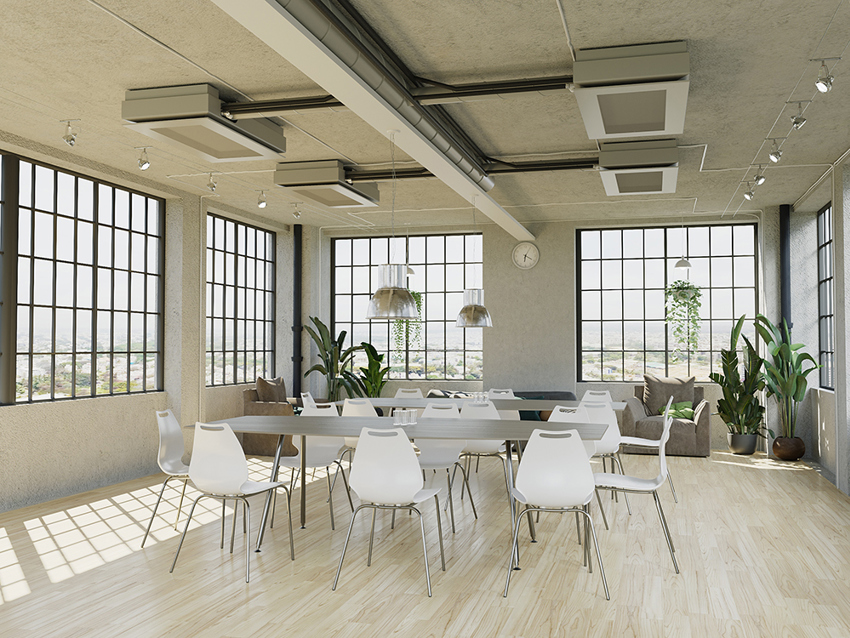Different methods for heating or cooling a room
Airborne cooling
In order to cool a room, heat needs to be transfered away from it. Airborne cooling is widely used in Northern Europe and is based on keeping the supply air cooler than the room air. In cases where it is cooler outdoors than indoors, the cooling will, at least to some extent, be free. That is energy efficient. The challenges posed by airborne cooling include the fact that air is a relatively inefficient energy medium. Meaning, the air flows have to be high to be able to transport enough heat away. A further challenge is that air quality and air temperature are linked which may result in chilled indoor environments if the air flows that ensure air quality are high but the air temperature is low. However, if the air temperature is raised, subsequently other rooms may be inadequately cooled. The conclusion is that it is more difficult to provide an individualised climate if the air quality and temperature cannot be adjusted separately. Duct heaters or duct coolers may be provided to the solution to work around the problem.


Waterborne cooling
Waterborne cooling is also widely used. The concept usually refers to either wet or dry cooling. In wet cooling, the temperature of the water distributed through the building is below dewpoint which means that condensation has to be dealt with. In dry cooling, the supply temperature is adjusted to be kept above dewpoint which prevents condensation. Wet cooling results in a higher temperature difference between the water and the air, allowing a higher cooling effect to be generated by more compact units. A fairly large amount of the heat transported away from a room stems from the fact that the air is dried and thus does not affect the air temperature. Latent cooling is the term used to describe energy eliminated from the room by drying the air, and sensible cooling is the term for lowering the room air temperature.
In the case of waterborne cooling, the cooling is distributed in more or less the same way as heating.
- Radiators are rare. Require dry cooling to avoid problems with condensation. The fairly low temperature difference maintained results in relatively low cooling capacity.
- Underfloor heating may cause cold floors that are not always comfortable underfoot, but it efficiently captures solar radiation that heats the floor.
- Active chilled beams combine cooling and ventilation and provides both airborne cooling and waterborne cooling. Work almost exclusively with dry cooling.
- Passive chilled beams are only for waterborne cooling, resulting in the need for convective air flow through a heat exchanger. The most common configuration will be a dry cooling solution.
- Fan convector unit is a common solution in Central Europe. Can be used with both dry and wet cooling.
- Chilled ceilings are for dry cooling, providing good comfort. The downside is the need to use large ceiling areas and the fairly high investment cost.
- In-wall heating is provided by hydronic tubes that are cast in the building’s concrete walls
With waterborne cooling, it is possible to adjust the air quality and thermal comfort independently of each other. This gives better options for achieving an individualised climate.

Airborne heating
Airborne heating is not the most common solution, but it works well in certain cases. Airborne heating means heating the ventilation air and distribute it in the building via the supply air. Air is a relatively inefficient energy medium compared to water, which means that the air for distributing the heat has to be quite warm, and the air flow has to be high. The fact that it is difficult to mix the warm supply air with the room's ambient air and that there is a risk of reduced ventilation efficiency is something to consider. In North America, solutions based on recirculated air are relatively common and in regions where the need for heating is modest, airborne heating can be a good alternative.
Waterborne heating
Waterborne solutions are commonly used for heating. Heat is then provided to the building using water as the energy medium. Distribution to rooms via
- Radiators
- Underfloor heating
- Active chilled beams
- Fan convector units
- Radiant panels
- Inwall heating
Other solutions for heat supply via electric sources might be electric radiators, fan convectors (cab heaters), radiant heaters, oil-filled radiators and similar.
Additional solutions are VRF systems, where the energy is transported by the means of a refrigerant which condenses in a terminal indoor unit. This solution is widely used in North America and in the Nordic countries.

Other examples of temperature media
Refrigerant
Products based on refrigerants as the energy medium, VRF systems, are also relatively widely used for distributing cooling or heating in buildings. Examples include reversible heat pumps of various kinds that allow heating or cooling to be generated depending on property requirements. VRF systems are popular in North America and Asia owing to the simplicity of their design, installation and system solutions where heating can be redirected from rooms requiring cooling to those requiring heating.
Air
In heat waves and when problems occur with high temperatures indoors, fans are widely used for a cooling effect. However, these products do nothing to lower the temperature, tend rather to raise it, but the movement of the air is perceived as having a cooling effect.